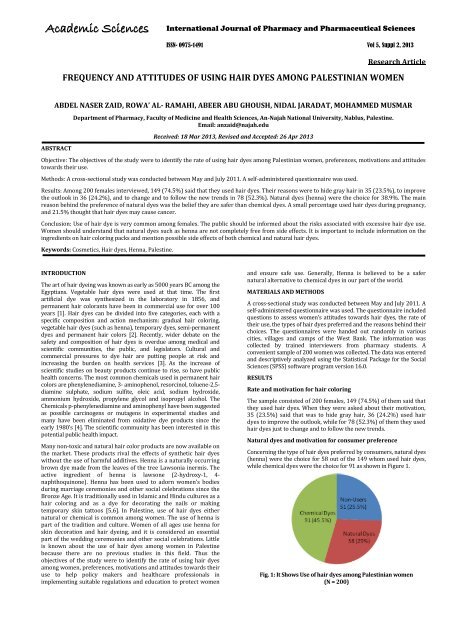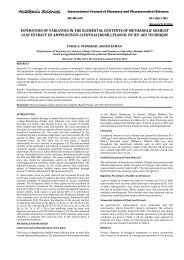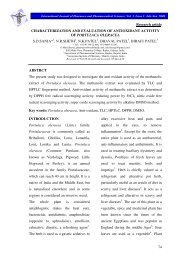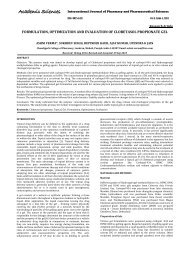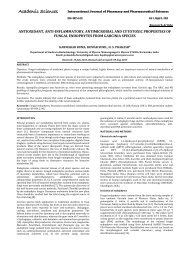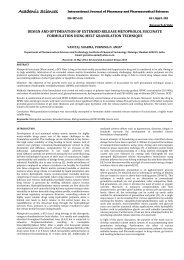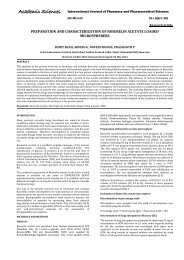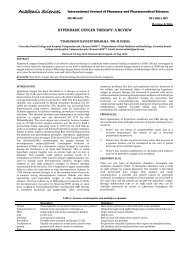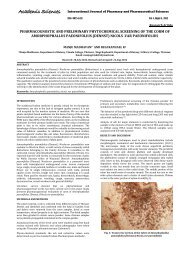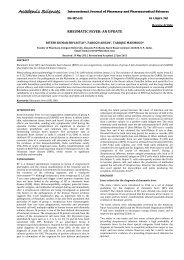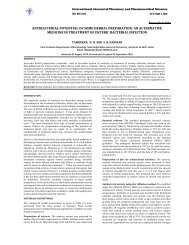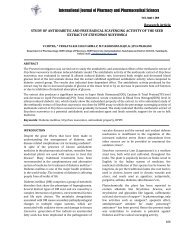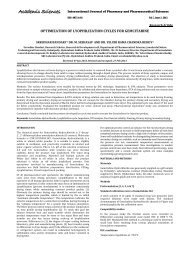frequency and attitudes of using hair dyes among palestinian women
frequency and attitudes of using hair dyes among palestinian women
frequency and attitudes of using hair dyes among palestinian women
Create successful ePaper yourself
Turn your PDF publications into a flip-book with our unique Google optimized e-Paper software.
Academic Sciences<br />
International Journal <strong>of</strong> Pharmacy <strong>and</strong> Pharmaceutical Sciences<br />
ISSN- 0975-1491 Vol 5, Suppl 2, 2013<br />
Research Article<br />
FREQUENCY AND ATTITUDES OF USING HAIR DYES AMONG PALESTINIAN WOMEN<br />
ABDEL NASER ZAID, ROWA’ AL- RAMAHI, ABEER ABU GHOUSH, NIDAL JARADAT, MOHAMMED MUSMAR<br />
ABSTRACT<br />
Department <strong>of</strong> Pharmacy, Faculty <strong>of</strong> Medicine <strong>and</strong> Health Sciences, An-Najah National University, Nablus, Palestine.<br />
Email: anzaid@najah.edu<br />
Received: 18 Mar 2013, Revised <strong>and</strong> Accepted: 26 Apr 2013<br />
Objective: The objectives <strong>of</strong> the study were to identify the rate <strong>of</strong> <strong>using</strong> <strong>hair</strong> <strong>dyes</strong> <strong>among</strong> Palestinian <strong>women</strong>, preferences, motivations <strong>and</strong> <strong>attitudes</strong><br />
towards their use.<br />
Methods: A cross-sectional study was conducted between May <strong>and</strong> July 2011. A self-administered questionnaire was used.<br />
Results: Among 200 females interviewed, 149 (74.5%) said that they used <strong>hair</strong> <strong>dyes</strong>. Their reasons were to hide gray <strong>hair</strong> in 35 (23.5%), to improve<br />
the outlook in 36 (24.2%), <strong>and</strong> to change <strong>and</strong> to follow the new trends in 78 (52.3%). Natural <strong>dyes</strong> (henna) were the choice for 38.9%. The main<br />
reason behind the preference <strong>of</strong> natural <strong>dyes</strong> was the belief they are safer than chemical <strong>dyes</strong>. A small percentage used <strong>hair</strong> <strong>dyes</strong> during pregnancy,<br />
<strong>and</strong> 21.5% thought that <strong>hair</strong> <strong>dyes</strong> may cause cancer.<br />
Conclusion: Use <strong>of</strong> <strong>hair</strong> dye is very common <strong>among</strong> females. The public should be informed about the risks associated with excessive <strong>hair</strong> dye use.<br />
Women should underst<strong>and</strong> that natural <strong>dyes</strong> such as henna are not completely free from side effects. It is important to include information on the<br />
ingredients on <strong>hair</strong> coloring packs <strong>and</strong> mention possible side effects <strong>of</strong> both chemical <strong>and</strong> natural <strong>hair</strong> <strong>dyes</strong>.<br />
Keywords: Cosmetics, Hair <strong>dyes</strong>, Henna, Palestine.<br />
INTRODUCTION<br />
The art <strong>of</strong> <strong>hair</strong> dyeing was known as early as 5000 years BC <strong>among</strong> the<br />
Egyptians. Vegetable <strong>hair</strong> <strong>dyes</strong> were used at that time. The first<br />
artificial dye was synthesized in the laboratory in 1856, <strong>and</strong><br />
permanent <strong>hair</strong> colorants have been in commercial use for over 100<br />
years [1]. Hair <strong>dyes</strong> can be divided into five categories, each with a<br />
specific composition <strong>and</strong> action mechanism: gradual <strong>hair</strong> coloring,<br />
vegetable <strong>hair</strong> <strong>dyes</strong> (such as henna), temporary <strong>dyes</strong>, semi-permanent<br />
<strong>dyes</strong> <strong>and</strong> permanent <strong>hair</strong> colors [2]. Recently, wider debate on the<br />
safety <strong>and</strong> composition <strong>of</strong> <strong>hair</strong> <strong>dyes</strong> is overdue <strong>among</strong> medical <strong>and</strong><br />
scientific communities, the public, <strong>and</strong> legislators. Cultural <strong>and</strong><br />
commercial pressures to dye <strong>hair</strong> are putting people at risk <strong>and</strong><br />
increasing the burden on health services [3]. As the increase <strong>of</strong><br />
scientific studies on beauty products continue to rise, so have public<br />
health concerns. The most common chemicals used in permanent <strong>hair</strong><br />
colors are phenylenediamine, 3- aminophenol, resorcinol, toluene-2,5-<br />
diamine sulphate, sodium sulfite, oleic acid, sodium hydroxide,<br />
ammonium hydroxide, propylene glycol <strong>and</strong> isopropyl alcohol. The<br />
Chemicals p-phenylenediamine <strong>and</strong> aminophenyl have been suggested<br />
as possible carcinogens or mutagens in experimental studies <strong>and</strong><br />
many have been eliminated from oxidative dye products since the<br />
early 1980’s [4]. The scientific community has been interested in this<br />
potential public health impact.<br />
Many non-toxic <strong>and</strong> natural <strong>hair</strong> color products are now available on<br />
the market. These products rival the effects <strong>of</strong> synthetic <strong>hair</strong> <strong>dyes</strong><br />
without the use <strong>of</strong> harmful additives. Henna is a naturally occurring<br />
brown dye made from the leaves <strong>of</strong> the tree Lawsonia inermis. The<br />
active ingredient <strong>of</strong> henna is lawsone (2-hydroxy-1, 4-<br />
naphthoquinone). Henna has been used to adorn <strong>women</strong>’s bodies<br />
during marriage ceremonies <strong>and</strong> other social celebrations since the<br />
Bronze Age. It is traditionally used in Islamic <strong>and</strong> Hindu cultures as a<br />
<strong>hair</strong> coloring <strong>and</strong> as a dye for decorating the nails or making<br />
temporary skin tattoos [5,6]. In Palestine, use <strong>of</strong> <strong>hair</strong> <strong>dyes</strong> either<br />
natural or chemical is common <strong>among</strong> <strong>women</strong>. The use <strong>of</strong> henna is<br />
part <strong>of</strong> the tradition <strong>and</strong> culture. Women <strong>of</strong> all ages use henna for<br />
skin decoration <strong>and</strong> <strong>hair</strong> dyeing, <strong>and</strong> it is considered an essential<br />
part <strong>of</strong> the wedding ceremonies <strong>and</strong> other social celebrations. Little<br />
is known about the use <strong>of</strong> <strong>hair</strong> <strong>dyes</strong> <strong>among</strong> <strong>women</strong> in Palestine<br />
because there are no previous studies in this field. Thus the<br />
objectives <strong>of</strong> the study were to identify the rate <strong>of</strong> <strong>using</strong> <strong>hair</strong> <strong>dyes</strong><br />
<strong>among</strong> <strong>women</strong>, preferences, motivations <strong>and</strong> <strong>attitudes</strong> towards their<br />
use to help policy makers <strong>and</strong> healthcare pr<strong>of</strong>essionals in<br />
implementing suitable regulations <strong>and</strong> education to protect <strong>women</strong><br />
<strong>and</strong> ensure safe use. Generally, Henna is believed to be a safer<br />
natural alternative to chemical <strong>dyes</strong> in our part <strong>of</strong> the world.<br />
MATERIALS AND METHODS<br />
A cross-sectional study was conducted between May <strong>and</strong> July 2011. A<br />
self-administered questionnaire was used. The questionnaire included<br />
questions to assess <strong>women</strong>’s <strong>attitudes</strong> towards <strong>hair</strong> <strong>dyes</strong>, the rate <strong>of</strong><br />
their use, the types <strong>of</strong> <strong>hair</strong> <strong>dyes</strong> preferred <strong>and</strong> the reasons behind their<br />
choices. The questionnaires were h<strong>and</strong>ed out r<strong>and</strong>omly in various<br />
cities, villages <strong>and</strong> camps <strong>of</strong> the West Bank. The information was<br />
collected by trained interviewers from pharmacy students. A<br />
convenient sample <strong>of</strong> 200 <strong>women</strong> was collected. The data was entered<br />
<strong>and</strong> descriptively analyzed <strong>using</strong> the Statistical Package for the Social<br />
Sciences (SPSS) s<strong>of</strong>tware program version 16.0.<br />
RESULTS<br />
Rate <strong>and</strong> motivation for <strong>hair</strong> coloring<br />
The sample consisted <strong>of</strong> 200 females, 149 (74.5%) <strong>of</strong> them said that<br />
they used <strong>hair</strong> <strong>dyes</strong>. When they were asked about their motivation,<br />
35 (23.5%) said that was to hide gray <strong>hair</strong>, 36 (24.2%) used <strong>hair</strong><br />
<strong>dyes</strong> to improve the outlook, while for 78 (52.3%) <strong>of</strong> them they used<br />
<strong>hair</strong> <strong>dyes</strong> just to change <strong>and</strong> to follow the new trends.<br />
Natural <strong>dyes</strong> <strong>and</strong> motivation for consumer preference<br />
Concerning the type <strong>of</strong> <strong>hair</strong> <strong>dyes</strong> preferred by consumers, natural <strong>dyes</strong><br />
(henna) were the choice for 58 out <strong>of</strong> the 149 whom used <strong>hair</strong> <strong>dyes</strong>,<br />
while chemical <strong>dyes</strong> were the choice for 91 as shown in Figure 1.<br />
Fig. 1: It Shows Use <strong>of</strong> <strong>hair</strong> <strong>dyes</strong> <strong>among</strong> Palestinian <strong>women</strong><br />
(N = 200)
Zaid et al.<br />
Int J Pharm Pharm Sci, Vol 5, Suppl 2, 485-488<br />
Among those who prefer natural <strong>dyes</strong>, 41 (70.1%) <strong>of</strong> them told that<br />
they add other natural materials to henna; the main natural<br />
materials were hibiscus, tea <strong>and</strong> chamomile. Twenty five declared<br />
that the motivation behind the addition <strong>of</strong> these natural materials<br />
was to reach the required degree <strong>of</strong> color, while 10 <strong>of</strong> them added<br />
natural materials to increase the adherence <strong>and</strong> permanence <strong>of</strong><br />
color on <strong>hair</strong> <strong>and</strong> only a minority <strong>of</strong> the interviewed females (6) had<br />
this practice due to their beneficial effects on the <strong>hair</strong>. When the<br />
consumers were asked to give the reasons behind the preference <strong>of</strong><br />
natural <strong>dyes</strong>, 23 out <strong>of</strong> the 58 said that was because they are safer<br />
than chemical <strong>dyes</strong>, 15 said that natural <strong>dyes</strong> give them the best<br />
natural color results, <strong>and</strong> 20 used natural <strong>dyes</strong> because they think<br />
they are useful to the scalp (Table 1).<br />
Table 1: It shows the reasons behind the preference <strong>of</strong> natural <strong>dyes</strong><br />
Reason Frequency (%) ( N = 58)<br />
They are safer than chemical <strong>dyes</strong> 23 (39.7%)<br />
They give the best natural color 15 (25.9%)<br />
They are useful to the scalp 20 (34.4%)<br />
Regarding any experience <strong>of</strong> side effects after <strong>using</strong> henna 8 out <strong>of</strong><br />
58 (13.8%) reported that they have experienced side effects due to<br />
the use <strong>of</strong> natural <strong>dyes</strong> as headache, contact allergic dermatitis, <strong>and</strong><br />
chemical burns.<br />
Synthetic <strong>dyes</strong> & motivation <strong>of</strong> consumer preference<br />
Among the consumers who declared that they preferred chemical<br />
<strong>dyes</strong>, 40 out <strong>of</strong> 91 (44%) said that the reason behind their<br />
preference <strong>of</strong> chemical <strong>dyes</strong> was that they are easier to use (require<br />
shorter time on <strong>hair</strong> <strong>and</strong> can be washed easily). Twenty four <strong>of</strong> the<br />
females preferred chemical <strong>dyes</strong> to obtain the required degree <strong>of</strong><br />
color, <strong>and</strong> 27 <strong>of</strong> them chose chemical <strong>dyes</strong> because they give wider<br />
options when choosing color (Table 2).<br />
Table 2: It shows the reasons behind the preference <strong>of</strong><br />
chemical <strong>dyes</strong><br />
Reason Frequency (%) ( N = 91)<br />
They are easier than natural <strong>dyes</strong> 40 (44%)<br />
They give the required degree <strong>of</strong> color 24 (26.4%)<br />
They give wider options <strong>of</strong> colors 27 (29.6%)<br />
The consumers were asked if they have suffered from any <strong>of</strong> the side<br />
effects that could be related to chemical <strong>hair</strong> <strong>dyes</strong>, the reported side<br />
effects were trichorrhexis (40.7%), itching <strong>and</strong> redness <strong>of</strong> the scalp<br />
(20.4%), <strong>and</strong> <strong>hair</strong> loss (29.6%).<br />
Preferred place to get chemical <strong>hair</strong> <strong>dyes</strong><br />
Concerning the ideal place to get the desired <strong>hair</strong> <strong>dyes</strong>, stores or<br />
supermarkets were chosen by 15 out <strong>of</strong> 91 (16.5%) <strong>of</strong> the females,<br />
28 (30.8%) <strong>of</strong> the females depended on community pharmacies to<br />
achieve their <strong>hair</strong> <strong>dyes</strong>, while more than half <strong>of</strong> them 48 (52.7%)<br />
declared that the beauty salon was their preferred place to get <strong>hair</strong><br />
<strong>dyes</strong>.<br />
Safety <strong>of</strong> <strong>hair</strong> <strong>dyes</strong> <strong>and</strong> use during pregnancy <strong>and</strong> lactation<br />
When <strong>women</strong> were asked if they have ever used any type <strong>of</strong> <strong>hair</strong><br />
<strong>dyes</strong> during pregnancy or breast-feeding, only 11 out <strong>of</strong> 149 (7.4%)<br />
said yes. When consumers were asked if they think that <strong>hair</strong> <strong>dyes</strong><br />
may cause cancer 32 (21.5%) <strong>of</strong> the females answered with yes with<br />
only 9.3% <strong>of</strong> them opted to consult a doctor or a pharmacist.<br />
DISCUSSION<br />
In this study, 149 (74.5%) <strong>of</strong> the females said that they have used<br />
<strong>hair</strong> <strong>dyes</strong>. These results are similar to other countries where a high<br />
percentage <strong>of</strong> <strong>women</strong> use <strong>hair</strong> <strong>dyes</strong>. In a survey from Saudi Arabia,<br />
82.6% <strong>of</strong> the participating females had dyed their <strong>hair</strong> at some point<br />
in their lives [7]. In Denmark 74.9% <strong>of</strong> <strong>women</strong> <strong>and</strong> 18.4% <strong>of</strong> men<br />
had at some point dyed their <strong>hair</strong>, <strong>and</strong> the median age for first use <strong>of</strong><br />
<strong>hair</strong> dye for both men <strong>and</strong> <strong>women</strong> was during the teenage years [8].<br />
About one third <strong>of</strong> <strong>women</strong> in Europe <strong>and</strong> North America, along with<br />
10% <strong>of</strong> men older than 40 years, use some type <strong>of</strong> <strong>hair</strong> dye [9]. Hair<br />
coloring is a dye that is used to color human <strong>hair</strong>. It is used for a<br />
variety <strong>of</strong> purposes; most commonly to return gray <strong>hair</strong> to its<br />
previous color, to change <strong>hair</strong> color to a more desirable shade, or to<br />
return <strong>hair</strong> to its original color after chemicals (e.g. <strong>hair</strong> dye) have<br />
discolored it [7]. The major motivation for <strong>hair</strong> dyeing in this study<br />
was to simply have a change <strong>of</strong> color <strong>and</strong> follow new trends (52.3%);<br />
other reasons were to improve the outlook by 24.2% <strong>and</strong> to hide<br />
gray <strong>hair</strong> by 23.5%. Concerning the type <strong>of</strong> <strong>hair</strong> <strong>dyes</strong> preferred by<br />
consumers, natural <strong>dyes</strong> (henna) were the choice for 58 (38.9%) <strong>of</strong><br />
the females. This shows that henna is widely used in our community.<br />
This can be expected as the use <strong>of</strong> henna dye is traditional in Islamic<br />
countries. It has a religious <strong>and</strong> social significance <strong>and</strong> it thought to<br />
be safe. In fact, when the consumers were asked to give the reasons<br />
behind the preference <strong>of</strong> natural <strong>dyes</strong>, 39.7% <strong>of</strong> them said that was<br />
because they are safer than chemical <strong>dyes</strong>, 25.9% <strong>of</strong> them said that<br />
natural <strong>dyes</strong> give them the best normal results. An interesting<br />
number <strong>of</strong> interviewed females (34.4%) declared that henna is<br />
beneficial to the scalp which may be investigated in a future<br />
research. Eight out <strong>of</strong> 58 (13.8%) reported that they have<br />
experienced side effects due to the use <strong>of</strong> natural <strong>dyes</strong> as headache,<br />
contact allergic dermatitis, <strong>and</strong> chemical burns.<br />
Regarding the safety, despite the wide spread use <strong>of</strong> natural henna,<br />
especially, in countries where henna art is traditionally practiced;<br />
reports <strong>of</strong> allergic contact dermatitis to natural henna are very rare<br />
in the literature. It can therefore be assumed that natural henna is a<br />
very weak skin allergen [6,10], <strong>and</strong> these allergic observations may<br />
be due to the addition <strong>of</strong> other components to henna in order to<br />
improve the quality <strong>of</strong> this product in terms <strong>of</strong> final color, time<br />
required to achieve the desired color <strong>and</strong> its lasting effect. In fact,<br />
these properties were reported by the consumers when they were<br />
asked about the motivations behind the addition <strong>of</strong> other home<br />
additives to henna. Indeed, this was confirmed by consumers who<br />
preferred the chemical <strong>dyes</strong>. Therefore, this may encourage some<br />
manufacturers to mix henna with other chemical <strong>dyes</strong> such as paraphenylenediamine<br />
(PPD), without mentioning these additives on the<br />
label <strong>of</strong> henna packages <strong>and</strong> this may be dangerous due to possible<br />
toxic effects <strong>of</strong> these added chemicals. In fact, PPD has been mixed<br />
with natural henna to give an ebony color (black henna) instead <strong>of</strong><br />
the orange/reddish color given by natural henna. The other reason<br />
for adding PPD to the natural henna is to speed up (shorten the<br />
time) <strong>of</strong> the tattooing <strong>and</strong> dyeing process, while natural henna<br />
staining takes 4 to 12 hours, addition <strong>of</strong> PPD can reduce this time to<br />
an hour or two <strong>and</strong> also there will be a longer lasting effect as well<br />
[5]. Thus, a new pattern <strong>of</strong> exposure to PPD has been recognized<br />
through henna which increases the risk <strong>of</strong> developing adverse health<br />
effects related to PPD. Acute allergic contact dermatitis, eczema,<br />
chemical burn, acute renal failure, acute <strong>and</strong> severe angioneurotic<br />
edema, abdominal pain <strong>and</strong> vomiting as adverse health effects<br />
associated with the use <strong>of</strong> henna containing PPD (black henna) are<br />
well documented in the literature [5]. It is also documented that PPD<br />
can bring about rhabdomyolysis which is the main cause <strong>of</strong> acute<br />
renal failure [11].<br />
It is good to mention that many other herbs like Kikar (Acacia<br />
arabica), bihi (Cydonia oblonga), bhringraj (Eclipta alba), patnag<br />
(Haematoxylon campechianum), akhrot (Juglans regia), narra<br />
(Petrocarpus inducus) <strong>and</strong> jabor<strong>and</strong>i (Pilocarpus jabor<strong>and</strong>i) can be<br />
used as a main ingredients in <strong>hair</strong> care preparations mainly for<br />
dyeing <strong>hair</strong> [12], Some other herbs as Emblica <strong>of</strong>ficinalis, Centella<br />
asiatica, Aloe vera, Ocimum sanctum <strong>and</strong> Eclipta can be used to<br />
improve <strong>hair</strong> growth [13]. So in summary, we can say that natural<br />
products might be safer than chemical products but they are not<br />
completely free from possible side effects <strong>and</strong> <strong>women</strong> need to know<br />
this in order to protect their health, <strong>and</strong> thus more public health<br />
awareness efforts must be conducted within communities <strong>using</strong><br />
them.<br />
Henna producers should not mix it with these chemicals or at least<br />
should provide henna packs with a label that contain complete<br />
information about the ingredients present in the provided henna<br />
formulation, since most consumers use it due to its claimed safety<br />
when compared with chemical <strong>dyes</strong>. Also, regulatory bodies should<br />
analyze <strong>and</strong> check on the quality <strong>of</strong> the henna packs arriving from<br />
various sources to check for presence <strong>of</strong> harmful ingredients or<br />
undisclosed ingredients <strong>and</strong> assure its freedom from the presence <strong>of</strong><br />
such chemicals. It is also a good idea to pose restrictions on points <strong>of</strong><br />
486
Zaid et al.<br />
Int J Pharm Pharm Sci, Vol 5, Suppl 2, 485-488<br />
sale for henna products so that consumers buy the packs from<br />
pharmacies where he will be well informed <strong>and</strong> get the advice he<br />
needs. It is reported in the literature that henna has been known to<br />
cause haemolytic crisis in glucose-6-phosphate dehydrogenase<br />
(G6PD) deficient infants <strong>and</strong> others. In the UAE, Raupp <strong>and</strong> his<br />
colleagues have reported the occurrence <strong>of</strong> haemolytic crisis in four<br />
G6PD-deficient children following topical application <strong>of</strong> henna; <strong>of</strong><br />
these a female neonate recovered after exchange transfusion, <strong>and</strong> a<br />
male infant died despite receiving a transfusion [14]. In particular<br />
people who have (G6PD) deficiency should be informed about the<br />
potentially serious adverse health effects <strong>of</strong> topical application <strong>of</strong><br />
henna. In addition, an awareness program should be established to<br />
inform the public about the risk <strong>of</strong> <strong>using</strong> henna mixed with PPD<br />
(black henna). Palestine is an Islamic country where many people<br />
traditionally use henna for different purposes such as h<strong>and</strong> <strong>and</strong> nail<br />
decoration <strong>and</strong> the dyeing <strong>of</strong> <strong>hair</strong>; it is also used to relieve pain <strong>and</strong><br />
pruritus <strong>and</strong> to treat infections. Hence, people should be aware <strong>of</strong><br />
the potential side effects <strong>of</strong> henna <strong>and</strong> warnings about the risk <strong>of</strong><br />
<strong>using</strong> henna are warranted. When the labels <strong>of</strong> henna products in<br />
our market were reviewed, it was found that some <strong>of</strong> them included<br />
information about ingredients, use, precautions, <strong>and</strong> expiry date<br />
while others did not.<br />
Side effects that could be related to chemical <strong>hair</strong> <strong>dyes</strong> were highly<br />
reported. Itching <strong>and</strong> redness <strong>of</strong> the scalp was reported with <strong>among</strong><br />
20.4% <strong>of</strong> the <strong>women</strong>, this is a very high percentage. For more than<br />
100 years aromatic amine family have been the main agents used in<br />
permanent <strong>hair</strong> <strong>dyes</strong>, <strong>and</strong> more than two thirds <strong>of</strong> <strong>hair</strong> <strong>dyes</strong><br />
currently contain PPD. This compound is an effective <strong>hair</strong> dye owing<br />
to its low molecular weight, its ability to penetrate the <strong>hair</strong> shaft <strong>and</strong><br />
follicle, its strong protein binding capacity, <strong>and</strong> its rapid<br />
polymerization in the presence <strong>of</strong> a coupler (a kind <strong>of</strong> catalyst) <strong>and</strong><br />
an oxidizing agent. However these properties also make PPD an<br />
ideal contact allergen <strong>and</strong>, indeed, it is <strong>among</strong> the most potent<br />
[3,15]. To prevent contact dermatitis to oxidative <strong>hair</strong> coloring<br />
products, a consumer test (skin allergy test, SAT) consisting <strong>of</strong> the<br />
open application <strong>of</strong> the colorant base prior to mixing with the<br />
developer is recommended 48 hours before <strong>hair</strong> coloring. The test is<br />
a suitable tool for the secondary prevention <strong>of</strong> contact allergic<br />
reactions to <strong>hair</strong> coloring products [16], but this practice is not<br />
common in our country. It is good to encourage this practice <strong>among</strong><br />
<strong>women</strong> with a history <strong>of</strong> possible side effects due to <strong>hair</strong> <strong>dyes</strong> to<br />
improve safety <strong>and</strong> try to avoid these effects in the future. Chemicals<br />
in <strong>hair</strong> <strong>dyes</strong> can also cause rhabdomyolysis, laryngeal edema, severe<br />
metabolic acidosis <strong>and</strong> acute renal failure [1].<br />
When <strong>women</strong> were asked if they have ever used <strong>hair</strong> <strong>dyes</strong> during<br />
pregnancy or breast-feeding, only 11 out <strong>of</strong> 149 (7.4%) said yes.<br />
This shows a high awareness <strong>and</strong> concern <strong>of</strong> fetus safety <strong>among</strong><br />
pregnant <strong>women</strong>. Studies regarding teratogenic effects <strong>of</strong> chemical<br />
<strong>hair</strong> <strong>dyes</strong> are not conclusive. Few studies have examined <strong>women</strong>'s<br />
use <strong>of</strong> <strong>hair</strong> dye before <strong>and</strong> during pregnancy. A 2005 study<br />
suggested an association between <strong>hair</strong> dye in pregnancy <strong>and</strong> the<br />
childhood cancer neuroblastoma [17], but other studies haven't<br />
reached the same conclusion [18]. Hair <strong>dyes</strong> are probably safe to use<br />
during pregnancy because so little dye is absorbed through the skin.<br />
However, it is still important to be cautious [4,7], therefore many<br />
health care providers recommend that pregnant <strong>women</strong> not use<br />
permanent <strong>hair</strong> <strong>dyes</strong> during the first three months. While the<br />
absorption through the skin is minimal, the concern is that breathing<br />
fumes during the process could be harmful to the developing baby.<br />
Permanent <strong>hair</strong> <strong>dyes</strong> contain ammonia which has a strong chemical<br />
fume. The recommendation is to avoid <strong>hair</strong> <strong>dyes</strong> that contain<br />
ammonia.<br />
When consumers were asked if they think that <strong>hair</strong> <strong>dyes</strong> may cause<br />
cancer, 21.5% <strong>of</strong> the females answered with yes. In a study from<br />
Saudi Arabia, 36.0% believed that <strong>hair</strong> <strong>dyes</strong> could cause cancer [7].<br />
An association between <strong>hair</strong> <strong>dyes</strong> <strong>and</strong> cancer is an important public<br />
health concerns since a high percentage <strong>of</strong> people use them.<br />
Regarding this risk, the results are inconsistent [4,10]. Non-<br />
Hodgkin’s lymphoma has been associated with use <strong>of</strong> <strong>hair</strong> coloring<br />
products, particularly long-term use <strong>of</strong> dark permanent <strong>dyes</strong> or use<br />
before 1980s, in several epidemiologic studies [19,21]. However,<br />
other investigators have not reported positive associations between<br />
ever use <strong>of</strong> permanent <strong>hair</strong> dye <strong>and</strong> lymphoma [22,23]. Several<br />
studies have suggested an increased risk <strong>of</strong> bladder cancer <strong>among</strong><br />
<strong>hair</strong>dressers, who are occupationally exposed to <strong>hair</strong> <strong>dyes</strong>. There<br />
has also been concern about a possible increased risk <strong>of</strong> bladder<br />
cancer <strong>among</strong> users <strong>of</strong> <strong>hair</strong> <strong>dyes</strong>. However, the association between<br />
personal <strong>hair</strong> dye use <strong>and</strong> bladder cancer risk remains inconclusive<br />
[24]. Women need to underst<strong>and</strong> that <strong>hair</strong> <strong>dyes</strong> might not be<br />
completely safe, so they should not be overused. Many natural<br />
health care experts recommend <strong>using</strong> natural <strong>dyes</strong> <strong>and</strong> doing <strong>hair</strong><br />
dyeing as infrequently as possible. Unfortunately, this study showed<br />
that henna which is the most widely used <strong>hair</strong> dye <strong>among</strong> <strong>women</strong> in<br />
this study was found to cause some side effects <strong>and</strong> is not<br />
completely safe. This finding was associated with presence <strong>of</strong><br />
hazardous chemicals in henna packages. As reported in many<br />
studies, the dangers <strong>of</strong> these chemicals is associated with long term<br />
use <strong>of</strong> henna <strong>and</strong> thus, the carcinogenic hazards <strong>of</strong> these chemicals<br />
may be more frequent. Hair color pr<strong>of</strong>essionals should consider<br />
wearing heavy plastic gloves <strong>and</strong> a mask to protect against fumes<br />
<strong>and</strong> try to schedule color work so that they have a break in between<br />
applications. Consumers, when possible, should look at less toxic<br />
options such as all natural coloring agents.<br />
Regarding the preferred place to get the desired <strong>dyes</strong>, it was<br />
interesting to see that only 30.8% <strong>of</strong> female prefer the community<br />
pharmacies where may receive better information about the<br />
direction <strong>and</strong> safety <strong>of</strong> these products. Therefore, it would be<br />
important to encourage consumers to get their <strong>hair</strong> <strong>dyes</strong> from<br />
pharmacy since pharmacists should aware about potential side<br />
effects <strong>and</strong> the quality <strong>of</strong> these products <strong>and</strong> accordingly they can<br />
advise the consumers especially in case <strong>of</strong> pregnancy or lactation.<br />
CONCLUSIONS<br />
It is concluded that a high percentage <strong>of</strong> <strong>women</strong> use <strong>hair</strong> <strong>dyes</strong> in our<br />
country <strong>and</strong> henna is widely used. The public should be informed<br />
about the risks associated with excessive <strong>hair</strong> dye use. Women<br />
should underst<strong>and</strong> that natural <strong>dyes</strong> are not completely free from<br />
side effects. It is important that there is labeling <strong>of</strong> the ingredients <strong>of</strong><br />
<strong>hair</strong> dye packs with date <strong>of</strong> manufacture <strong>and</strong> expiry. In addition,<br />
instructions on use should be included so that sensitive individuals<br />
are aware <strong>of</strong> any possible allergenic ingredients prior to purchase<br />
<strong>and</strong> use. Ministry <strong>of</strong> Health should oblige importers to report<br />
important relevant information on ingredients, use, precautions,<br />
possible side effects <strong>and</strong> expiry date on products. It should also<br />
conduct analysis on coloring products for hazardous chemicals such<br />
as PPD <strong>and</strong> restrict sale to pharmacies where proper advice can be<br />
provided to consumers.<br />
REFERENCES<br />
1. Sampathkumar K, Yesudas S. Hair dye poisoning <strong>and</strong> the<br />
developing world. J Emerg Trauma Shock 2009; 2(2): 129-131.<br />
2. Boldoc C, Sapiro, J. Hair care products: Waving, straightening,<br />
conditioning <strong>and</strong> coloring. Clin Dermatol 2001; 19 (4): 431-<br />
436.<br />
3. McFadden JP, White IR, Frosch PJ, Sosted H, Johansen JD,<br />
Menne T. Allergy to <strong>hair</strong> dye. BMJ 2007; 334(7587): 220.<br />
4. Chua-Gocheco A, Bozzo P, Einarson A. Safety <strong>of</strong> <strong>hair</strong> products<br />
during pregnancy- personal use <strong>and</strong> occupational exposure.<br />
Can Fam Physician 2008; 54 (10): 1386-1388.<br />
5. Al-Suwaidi A, Ahmed H. Determination <strong>of</strong> paraphenylenediamine<br />
(PPD) in henna in the United Arab Emirates.<br />
Int J Environ Res Public Health 2010; 7(4): 1681-1693.<br />
6. Polat M, Dikilitaş M, Oztaş P, Alli N. (2009) Allergic contact<br />
dermatitis to pure henna. Dermatology Online Journal 2009;<br />
15(1):15.<br />
7. AlGhamdi KM, Moussa NA. Knowledge <strong>and</strong> practices <strong>of</strong>, <strong>and</strong><br />
<strong>attitudes</strong> towards, the use <strong>of</strong> <strong>hair</strong> <strong>dyes</strong> <strong>among</strong> females visiting a<br />
teaching hospital in Riyadh, Saudi Arabia. Ann Saudi Med 2011;<br />
31(6):613-9.<br />
8. Søsted H, Hesse U, Menné T, Andersen KE, Johansen JD. Contact<br />
dermatitis to <strong>hair</strong> <strong>dyes</strong> in a Danish adult population: an<br />
interview-based study. Br J Dermatol 2005; 53(1):132-5.<br />
9. Takkouche B, Etminan M, Montes-Martínez A. Personal use <strong>of</strong><br />
<strong>hair</strong> <strong>dyes</strong> <strong>and</strong> risk <strong>of</strong> cancer: a meta-analysis. JAMA 2005;<br />
293(20):2516–2525.<br />
487
Zaid et al.<br />
Int J Pharm Pharm Sci, Vol 5, Suppl 2, 485-488<br />
10. Gonzalo-Garijo MA, Fern<strong>and</strong>ez Duran DA, Pérez-Calderón R,<br />
Sánchez-Carvajal J. Allergic contact dermatitis due to a<br />
temporary henna tattoo, a <strong>hair</strong> dye, <strong>and</strong> a marker pen. J<br />
Investig Allergol <strong>and</strong> Clin Immunol 2008; 18(3):226-267.<br />
11. Yabe K. The effect <strong>of</strong> a p-phenylenediamine containing <strong>hair</strong> dye<br />
on the Ca2+ mobilization in the chemically skinned skeletal<br />
muscle <strong>of</strong> the rat. Nippon Hoigaku Zassi 1992; 46:132–40.<br />
12. Tomer K, Sethiya NK, Singh V. Preparation <strong>and</strong> characterization<br />
<strong>of</strong> some bolyherbal formulation for evaluation <strong>of</strong> <strong>hair</strong> colorant<br />
effects. Int J Pharm Pharm Sci 2009; 1(2): 93-97.<br />
13. Jain R, Jain NK, Singh N, Gnanach<strong>and</strong>ran AK, Gokulan PD.<br />
Development <strong>and</strong> evaluation <strong>of</strong> polyherbal ointment for <strong>hair</strong><br />
growth activity. Int J Pharm Pharm Sci 2011; 3, Suppl 2: 180-182.<br />
14. Raupp P, Hassan JA, Varughese M, Kristiansson B. Henna causes<br />
life threatening haemolysis in glucose-6-phosphate<br />
dehydrogenase deficiency. Arch Dis Child 2001; 85(5):411-412.<br />
15. Dogra A, Minocha YC, Kaur S. Adverse reactions to cosmetics.<br />
Indian J Dermatol Venereol Leprol 2003; 69(2):165-167.<br />
16. Krasteva M, Cottin M, Cristaudo A, Lainé G, Nohynek G, Orton D.<br />
Sensitivity <strong>and</strong> specificity <strong>of</strong> the consumer open skin allergy<br />
test as a method <strong>of</strong> prediction <strong>of</strong> contact dermatitis to <strong>hair</strong><br />
<strong>dyes</strong>. Eur J Dermatol 2005; 15(1):18-25.<br />
17. McCall EE, Olshan AF, Daniels JL. Maternal <strong>hair</strong> dye use <strong>and</strong> risk<br />
<strong>of</strong> neuroblastoma in <strong>of</strong>fspring. Cancer Causes <strong>and</strong> Control 16(6):<br />
743-748.<br />
18. Kersemaekers, WM, Roeleveld N, Zielhuis GA. Reproductive<br />
disorders due to chemical exposure <strong>among</strong> <strong>hair</strong>dressers. Sc<strong>and</strong><br />
J Work Environ Health 1995; 21(5):325-234.<br />
19. Zhang Y, Sanjose SD, Bracci PM, Morton LM, Wang R, Brennan<br />
P. Personal use <strong>of</strong> <strong>hair</strong> dye <strong>and</strong> the risk <strong>of</strong> certain subtypes <strong>of</strong><br />
non-Hodgkin lymphoma. Am J Epidemiol 2008; 167(11): 1321–<br />
1331.<br />
20. Sangrajrang S, Renard H, Kuhaprema T, Pornsopone P,<br />
Arpornwirat W, Brennan P. Personal use <strong>of</strong> <strong>hair</strong> <strong>dyes</strong>--<br />
increased risk <strong>of</strong> non-Hodgkin's lymphoma in Thail<strong>and</strong>. Asian<br />
Pac J Cancer Prev 2011; 12(9): 2393-2396.<br />
21. Benavente Y, Garcia N, Domingo-Domenech E, Alvaro T, Font R,<br />
Zhang Y, et al. Regular use <strong>of</strong> <strong>hair</strong> <strong>dyes</strong> <strong>and</strong> risk <strong>of</strong> lymphoma in<br />
Spain. Int J Epidemiol 2005; 34(5):1118-1122.<br />
22. Tavani A, Negri E, Franceschi S, Talamini R, Serraino D, La<br />
Vecchia C. (2005) Hair dye use <strong>and</strong> risk <strong>of</strong> lymphoid neoplasms<br />
<strong>and</strong> s<strong>of</strong>t tissue sarcomas. Int J Cancer 2005; 113(4):629-631.<br />
23. Holly EA, Lele C, Bracci PM. Hair-color products <strong>and</strong> risk for<br />
non-Hodgkin's lymphoma: a population-based study in the<br />
San Francisco bay area. Am J Public Health 1998;<br />
88(12):1767-73.<br />
24. Ros MM, Gago-Dominguez M, Aben KK, Bueno-de-Mesquita HB,<br />
Kampman E, Vermeulen SH, et al. Personal <strong>hair</strong> dye use <strong>and</strong> the<br />
risk <strong>of</strong> bladder cancer: a case-control study from The<br />
Netherl<strong>and</strong>s. Cancer Causes Control 2012; 23(7):1139-1148.<br />
488


